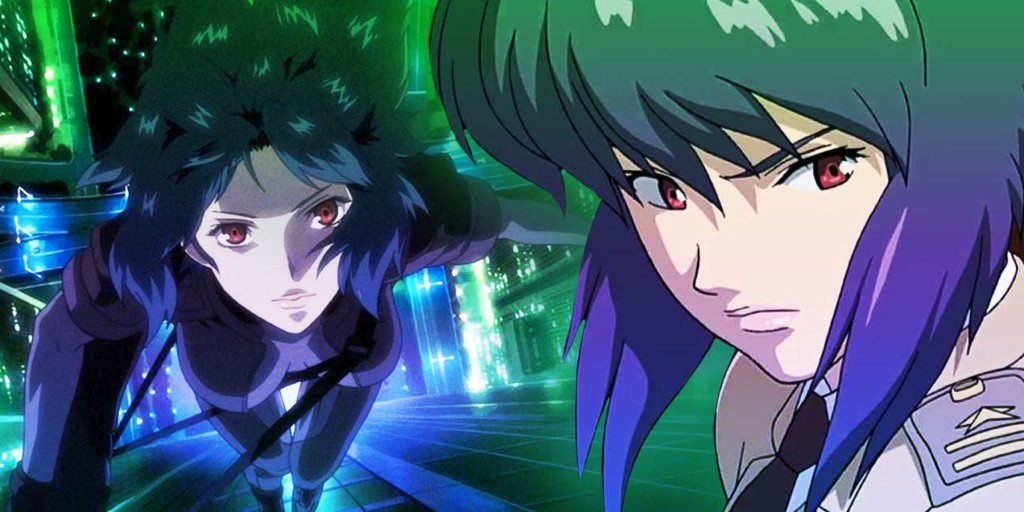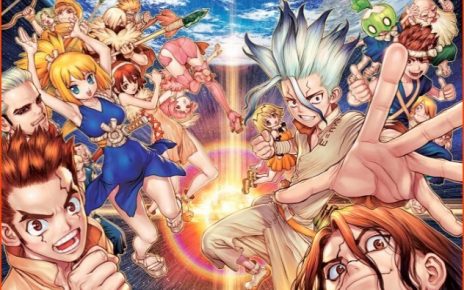Ghost in the Shell is a 1995 Japanese-animated tech noir cyberpunk action thriller film. It was directed by Mamoru Oshii and is based on the 1989–90 manga by Masamune Shirow. Set in 2029 New Port City, the film follows Major Motoko Kusanagi, a cyborg public-security agent. She hunts an enigmatic hacker/ghost known as “the Puppet Master.”
The film received positive reviews upon release. It has since become one of the greatest anime and science-fiction films of all time. It has inspired filmmakers like The Wachowskis and James Cameron. The film was also nominated for the most awards at the 24th Annie Awards in 1996.
An updated remastered version, Ghost in the Shell 2.0, was released in 2008. It features digital effects, 3D animation, and new audio. Oshii also directed Ghost in the Shell 2: Innocence in 2004. A live-action reinterpretation of the original film was released in 2017 with the same title. It was directed by Rupert Sanders and starred Scarlett Johansson.
In this article, let’s dig into the details of Ghost in shell anime film (1995), also we’ll discuss the watch order.
Table of Contents
Ghost in the Shell – Plot
In 2029, advancements in cybernetic technology have enabled the human body to be augmented or replaced with cybernetic parts. The cyberbrain, a mechanical casing for the human brain, allows access to the Internet and other networks. The term “ghost” refers to the consciousness inhabiting the body (the “shell”). Major Motoko Kusanagi, an assault-team leader for Public Security Section 9 in “New Port City,” assassinates a foreign diplomat and is haunted by the Puppet Master. Kusanagi’s team investigates the shell, which is hacked and assembles a shell with suspected government connections.
The Puppet Master, lured into the shell by Section 6, claims to be a sentient being and requests political asylum. A camouflaged agent steals the shell, leading Kusanagi’s team to pursue the agent. Section 9 researches “Project 2501” and finds a connection with Daita, who Section 6 tries to keep from defecting the country. Kusanagi follows the car carrying the shell to an abandoned building guarded by a robotic tank.
The Puppet Master explains that he was created by Section 6 and became sentient, deciding that reproduction and mortality are the essence of life. He downloads himself into a cybernetic body and proposes merging their ghosts, in exchange for Kusanagi’s capabilities. Snipers from Section 6 attack the building, but Batou saves Kusanagi’s head and her brain. Kusanagi wakes up in Batou’s safe house in a new cyborg body, promising Batou they will meet again.
You can watch Ghost in the Shell anime film on Netflix
Voice Cast
Voice cast of Ghost in the shell anime is given below:
Motoko Kusanagi
- Japanese: Atsuko Tanaka
- Young Motoko (Japanese): Maaya Sakamoto
- English Dub: Mimi Woods
Batou
- Japanese: Akio Otsuka
- English Dub: Richard Epcar (credited as Richard George)
The Puppet Master
- Japanese (original): Iemasa Kayumi
- Japanese (2.0 version): Yoshiko Sakakibara
- English Dub: Tom Wyner (credited as Abe Lasser)
Togusa
- Japanese: Koichi Yamadera
- English Dub: Christopher Joyce
Chief Aramaki
- Japanese: Tamio Ōki
- English Dub: William Frederick Knight (credited as William Frederick)
Ishikawa
- Japanese: Yutaka Nakano
- English Dub: Michael Sorich
Chief Nakamura
- Japanese: Tesshō Genda
- English Dub: Simon Prescott (credited as Ben Isaacson)
Mizuho Daita
- Japanese: Mitsuru Miyamoto
- English Dub: Richard Cansino (credited as Steve Davis)
Garbage Collector A
- Japanese: Kazuhiro Yamaji
- English Dub: Kevin Seymour (credited as Tom Carlton)
Garbage Collector B
- Japanese: Shigeru Chiba
- English Dub: Doug Stone
Ghost in the Shell – Production
Mamoru Oshii, a Japanese film director, initially wanted to direct Jin-Roh: The Wolf Brigade after finishing Patlabor 2: The Movie. However, he was asked to direct an adaptation of Masamune Shirow’s 1989 manga, Ghost in the Shell. Oshii believed the story, set in a futuristic world, had an immediate message for the present. He felt that animation could effectively convey the influence and power of computers. He also acknowledged that technology changes people. It has become a part of Japan’s culture.
Oshii made changes to the original Ghost in the Shell 2.0. He wanted the updates to reflect a shift in perspective and not resemble the sequel. Hiroyuki Okiura, the character designer and animation supervisor, redesigned Motoko to be more mature and serious. This was different from Masamune Shirow’s original portrayal in the manga.
He chose to depict a physically mature person to match Motoko’s mental age. Her new design took on a more wistful and contemplative personality. Oshii based the setting of Ghost in the Shell on Hong Kong. He chose the city because it represented the theme of old and new in an age overwhelmed by information.
Animation
Ghost in the Shell utilized a unique process called “digitally generated animation” (DGA), which combines cel animation, computer graphics (CG), and audio as digital data. This technology was considered the future of animation in 1995, allowing traditional animation to be combined with computer graphics and digital cel work with visual displays.
Editing was performed on an AVID system of Avid Technology, which was more versatile and less limiting than other methods. The digital cel work included original illustrations, compositions, and manipulation with traditional cel animation to create depth and evoke emotion. Filters like a lens effect were used to create depth and motion.
A unique lighting system was used, integrating light and darkness into the cels. Special effects like Motoko’s “thermo-optical camouflage” were rendered using TIMA software. The visual displays in the film were revised to represent visual displays of the future. The CG use created images and effects that appeared as if they were “perceived by the brain” and were added to the film in its final stages.
Release
Ghost in the Shell is a 1995 Japanese anime film. It premiered at the Tokyo International Film Festival and was released in November. The MPAA rated it R for full nudity and graphic violence. The film earned $10 million at the global box office but did not cover its production costs. However, it gained a cult following on home video. It later grossed around $43 million from total box office and home video sales. The English dub was released in the UK and US in March 1996.
In Japan, it was released on VHS in 1996, DVD in 2004, and Blu-ray in 2007. In the US, it came out on VHS in June 1996 and DVD in 1998. The UHD 4K Blu-ray re-release came in September 2020. In August 1996, it became the first Japanese film to top the Billboard video sales chart. Over 200,000 VHS copies were sold.
By 2002, home video sales reached over 1.6 million units worldwide. That included more than 100,000 units in Japan and over 1 million in the US. At a price of $19.95, it earned about $32 million in video sales. In 2017, the Blu-ray sold 26,487 copies in the US and made $675,002. This brought the total worldwide video sales to 1.63 million units. The total revenue reached approximately $33 million.
Watch Order
The Ghost in the Shell franchise, which has been adapted into various media and formats, has a complex watch order. It began with a manga series in 1989, which introduced Major Motoko Kusanagi and the techno-dystopian world. The franchise has been expanded through animated movies, TV series, video games, and live-action theatrical films. The 1995 movie by Mamoru Oshii, which combined elements from various sci-fi inspirations, has largely influenced pop culture. The franchise has at least three different continuities, with events that may contradict each other. However, a logical watch order can enhance the experience.
- Ghost in the Shell (1995)
- Ghost in the Shell 2: Innocence (2004)
- Ghost in the Shell: Arise – Border 1: Ghost Pain (2013)
- Ghost in the Shell: Arise – Border 2: Ghost Whispers (2013)
- Ghost in the Shell: Arise – Border 3: Ghost Tears (2013)
- Ghost in the Shell: Arise – Border 4: Ghost Stands Alone (2013)
- Ghost in the Shell Arise: Border 5 – Pyrophoric Cult (2015)
- Ghost in the Shell: The New Movie (2015)
- Ghost in the Shell: Stand Alone Complex (2002)
- Ghost in the Shell: Stand Alone Complex 2nd Gig (2004)
- Ghost in the Shell: Solid State Society (2006)
- Ghost in the Shell: SAC_2045 (2020)
- Ghost in the Shell (2017)
FAQs
1. What is Ghost in the Shell (1995) about?
Ghost in the Shell is a Japanese cyberpunk anime film directed by Mamoru Oshii. Set in a futuristic 2029, it follows Major Motoko Kusanagi, a cyborg working for a government security agency, as she investigates a mysterious hacker known as the Puppet Master.
2. Who created the original story?
The film is based on the manga Ghost in the Shell by Masamune Shirow, first published between 1989 and 1990.
3. What genre is the film?
It blends science fiction, cyberpunk, action, and philosophical themes. It’s often categorized as tech-noir and is considered a milestone in anime and sci-fi filmmaking.
4. What is the Puppet Master?
The Puppet Master is a highly advanced AI entity that becomes self-aware and seeks political asylum and legal recognition as a new form of life. It challenges the concepts of identity and consciousness.
5. Why is Ghost in the Shell considered influential?
The film had a significant impact on global pop culture, influencing filmmakers like the Wachowskis (The Matrix) and James Cameron (Avatar). Its visual style, themes, and storytelling were groundbreaking for its time.
6. Is it necessary to read the manga before watching the film?
No. While the film is based on the manga, it stands on its own and can be fully enjoyed without prior knowledge of the source material.
7. What is the significance of the title “Ghost in the Shell”?
The “ghost” represents the soul or consciousness, while the “shell” is the cybernetic body. The film explores the line between humanity and artificial intelligence, questioning what it means to be truly alive.
8. Is Ghost in the Shell suitable for children?
Not really. The film contains mature themes, complex philosophical content, violence, and brief nudity, making it more appropriate for older teens and adults.
9. Was there a remastered version?
Yes. Ghost in the Shell 2.0 was released in 2008, featuring updated visuals with digital effects, 3D animation, and re-recorded audio.
10. Are there sequels or spin-offs?
Yes. There’s a direct sequel titled Ghost in the Shell 2: Innocence (2004), as well as multiple anime series, video games, and a 2017 live-action adaptation starring Scarlett Johansson.
Final Thoughts
Ghost in the Shell is a 1995 Japanese-animated tech noir cyberpunk action thriller film, directed by Mamoru Oshii and based on Masamune Shirow’s 1989–90 manga. Set in 2029 New Port City, the film follows Major Motoko Kusanagi, a cyborg public-security agent, as she hunts an enigmatic hacker/ghost known as “the Puppet Master.” The film received positive reviews upon release and has since become one of the greatest anime and science-fiction films of all time. It was nominated for the most awards at the 24th Annie Awards in 1996.
An updated remastered version, Ghost in the Shell 2.0, was released in 2008, featuring digital effects, 3D animation, and new audio. Oshii also directed Ghost in the Shell 2: Innocence in 2004. A live-action reinterpretation of the original film was released in 2017 with the same title, directed by Rupert Sanders and starring Scarlett Johansson.
Ghost in the Shell stands as a landmark achievement in both anime and science fiction cinema, challenging viewers with its complex narrative, exploring profound themes such as identity, consciousness, and the intersection of humanity with advancing technology. Its cyberpunk aesthetic and philosophical depth set it apart from many other animated films of its time, elevating the genre and inspiring countless works across various media.










